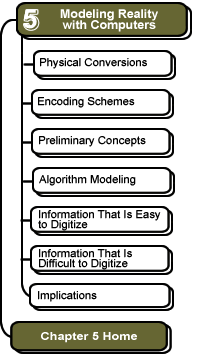

Chapter 5: Modeling Reality with Computers
The concepts and ideas with which you should be familiar are included on the chapter 5 checklist. Print out the checklist to use as a study/notes guide while working through the chapter.

Computers are a universal machine of sorts. They can emulate almost any imaginable process or task. Even if we will never achieve true "artificial intelligence," even today's computers can sometimes seem to have capabilities akin to human intelligence, such as the defeat of the world chess champion, Gary Kasporov by a computer, the IBM Deep Blue machine. A computer can control external devices, such as common desktop peripherals like printers or speakers, and also complex machinery, such as the controls of an aircraft. Most of these tasks require the computer software to model some aspect of reality, at least to a limited extent. The computer must maintain some representation of the world in order to compute appropriate outputs for a given set of inputs. For example, Deep Blue must maintain a model of the chess board positions, the rules for legal moves, a memory (database) of notable historical games, and a logical system for evaluating the value of a given move.
Modeling reality inside a computer is done at several levels:
- Physical conversion of input signals into digital signals (as well as converting digital signals into an output signal)
- Encoding schemes for representing information in binary
- Algorithmic modeling of physical processes
![]()
![]()
These pages were written by Steven H. VanderLeest and Jeffrey Nyhoff and
edited by Nancy Zylstra
©2005 Calvin University (formerly Calvin College), All Rights Reserved
If you encounter technical errors, contact computing@calvin.edu.